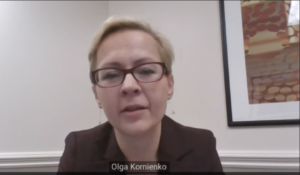
EZDRM: 20 Years and Counting For DRMaaS
As EZDRM marked its 20th year in the streaming security industry, the company took a deep dive into the technology, its history and the marketplace changes that have been seen over that time with long-time colleagues and partners.
“We got into” digital rights management (DRM) “strictly because, at that point, that was the technology we had,” Olga Kornienko, COO and co-founder of EZDRM, said Jan. 26, during the webinar “EZDRM: Protecting Streaming Revenue: 20 Years and Counting of DRMaaS.”
David Eisenbacher, CEO and co-founder of EZDRM, and Kornienko “actually met working for a bank and we originally talked about launching a streaming service in 2001,” she recalled, adding: “The streaming service idea for the streaming service came only and strictly because David had access to Windows Media and specifically Windows Media DRM.”
 “In 2001, we launched a company that was doing streaming,” she said. But, “with that said, two kids working for a bank did not have access to any content that was of any importance,” she noted.
“In 2001, we launched a company that was doing streaming,” she said. But, “with that said, two kids working for a bank did not have access to any content that was of any importance,” she noted.
“We tried to do an independent film streaming company but 20-something videos do not a streaming service make,” she conceded.
“When we finally decided to call it quits, Microsoft released Windows Media DRM version 7, where we could give people a DRM profile and actually not worry about client management or anything else,” she said, adding: “Basically, at that point, we said: “This is what we want to do and we’re going to do it really well. We’re going to make it simple and we’re going to stick to the basic principle of treat people the way they want to be treated and the way we want to be treated, explain things and see where it takes us. “
She noted: “Obviously we would not be here at all if it wasn’t for everybody else in the industry, for partners, for clients, and for all the genius minds you have on this panel.”
Microsoft’s Role
“In 2003, I was doing a ton of work with Apple and QuickTime who were trying to emerge into the space but really it was dominated by Real Technologies,” recalled Andy Beach, CTO for media and entertainment at Microsoft. “They were huge at the time,” he said of Real, noting: “Particularly if you think about live streaming, their server was driving a lot of the live content that that was available.”
And “a lot of the content that was there was really news-focused … more so than anything else,” recalled Beach. “A lot of the content that we think about today in terms of concerts and other things … tended to be a little more offline so that you could have better quality, better compression, other elements that went into it,” he said.
But Beach added: “Windows played a huge role in in those days as well. And actually some of the early radio streaming that they did around Windows Media Audio was something that we invariably spent a lot of time focusing on.”
The ‘Special Sauce’
“When this whole thing started, it was a novelty,” recalled Eisenbacher. “It was cool technology. We were all hyped about it. And, at that point in time, we all were thinking, ‘Well, the best way to do it is my way.”
 But he added: “As it became adopted, the actual mindset of trying to own that entire media pipeline because you had the special sauce has fallen away, meaning that basically now everyone expects it to work. I mean, nowadays everyone expects to be able to watch any piece of content they want at any point in time. And now it’s about the user experience.”
But he added: “As it became adopted, the actual mindset of trying to own that entire media pipeline because you had the special sauce has fallen away, meaning that basically now everyone expects it to work. I mean, nowadays everyone expects to be able to watch any piece of content they want at any point in time. And now it’s about the user experience.”
It is easy to understand where consumers are coming from, he conceded. “When you hit play or you want to play … you no longer care about Android or iOS or browser or smart TV. You just expect to watch your content. And that’s the driving force around these changes. It is no longer around the special sauce. It’s about everything working together.”
Also speaking were Will Law, chief architect for the Edge Technology Group at Akamai Technologies, and Tricia Iboshi, CEO of computer software company Videon. The panel was moderated by Stuart Thomson, editor for Digital TV Europe.
